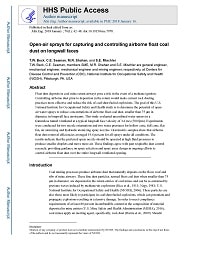Mining Publication: Open-air Sprays for Capturing and Controlling Airborne Float Coal Dust on Longwall Faces
Original creation date: January 2018
Authors: T Beck, C Seaman, M Shahan, S Mischler
Float dust deposits in coal mine return airways pose a risk in the event of a methane ignition. Controlling airborne dust prior to deposition in the return would make current rock dusting practices more effective and reduce the risk of coal-dust-fueled explosions. The goal of this U.S. National Institute for Occupational Safety and Health study is to determine the potential of open-air water sprays to reduce concentrations of airborne float coal dust, smaller than 75 µm in diameter, in longwall face airstreams. This study evaluated unconfined water sprays in a featureless tunnel ventilated at a typical longwall face velocity of 3.6 m/s (700 fpm). Experiments were conducted for two nozzle orientations and two water pressures for hollow cone, full cone, flat fan, air atomizing and hydraulic atomizing spray nozzles. Gravimetric samples show that airborne float dust removal efficiencies averaged 19.6 percent for all sprays under all conditions. The results indicate that the preferred spray nozzle should be operated at high fluid pressures to produce smaller droplets and move more air. These findings agree with past respirable dust control research, providing guidance on spray selection and spray array design in ongoing efforts to control airborne float dust over the entire longwall ventilated opening.

- Benchmarking Longwall Dust Control Technology and Practices
- Characterization of Airborne Float Coal Dust Emitted During Continuous Mining, Longwall Mining, and Belt Transport
- Control of Respirable Dust
- Controlling Dust Exposures in Longwall Mining Utilizing A Simple Barrier
- Dust Control Practices for Underground Coal Mining
- The Effects of Water Spray Placement for Controlling Respirable Dust and Face Methane Concentrations
- Evaluation of the Approach to Respirable Quartz Exposure Control in U.S. Coal Mines
- Status of a Tapered Element, Oscillation Microbalance-Based Continuous Respirable Coal Mine Dust Monitor
- Suggestion of a Cause-and-Effect Relationship Among Coal Rank, Airborne Dust, and Incidence of Workers' Pneumoconiosis
- Technology News 515 - Float Coal Dust Explosion Hazards